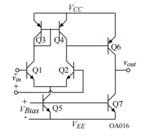julian403
Full Member level 5
What do you think about this ampliffier? yes, I know the power step, class AB, has not polarization (but whit multisim an error occurs if I place the polarization diodes)

This is the output signal (for me it's allmost rail to rail :shock

and this is the bandwidth

Until now it had never been possible to obtain a great voltage gain to exite the power stage.
But seeing the TL082's schematic I realized that there were current sources. So there I realized that the current source allowed me to have a proper polarization and have a high impedance collector, hoe.
I make it only whit BC548 because it's cheaper and easy to find and for the power stage I'm going to use 2SC5200 and 2SC1943.
The signal distortion I think it's for the software simulations.
And this it's the proteus simulation



Why the higher the gain less resistance, in the resistances of the polarization of the power stage?

This is the output signal (for me it's allmost rail to rail :shock

and this is the bandwidth

Until now it had never been possible to obtain a great voltage gain to exite the power stage.
But seeing the TL082's schematic I realized that there were current sources. So there I realized that the current source allowed me to have a proper polarization and have a high impedance collector, hoe.
I make it only whit BC548 because it's cheaper and easy to find and for the power stage I'm going to use 2SC5200 and 2SC1943.
The signal distortion I think it's for the software simulations.
And this it's the proteus simulation



Why the higher the gain less resistance, in the resistances of the polarization of the power stage?
Last edited:


![____amplificador,_el_de_compensación_en_frecuencia,_necesario_para_que_un[1].gif ____amplificador,_el_de_compensación_en_frecuencia,_necesario_para_que_un[1].gif](https://www.edaboard.com/data/attachments/68/68118-4a72b8eed09c893a0a3bf17361253286.jpg)





